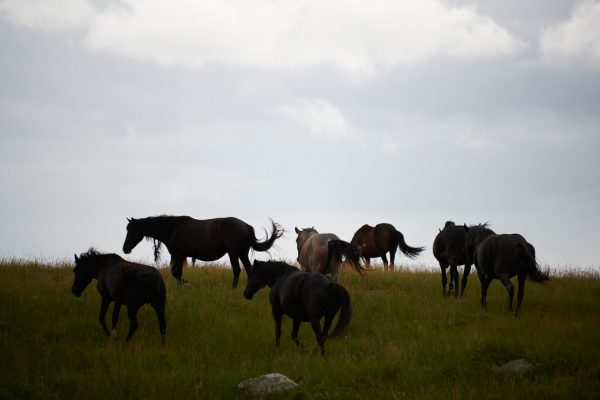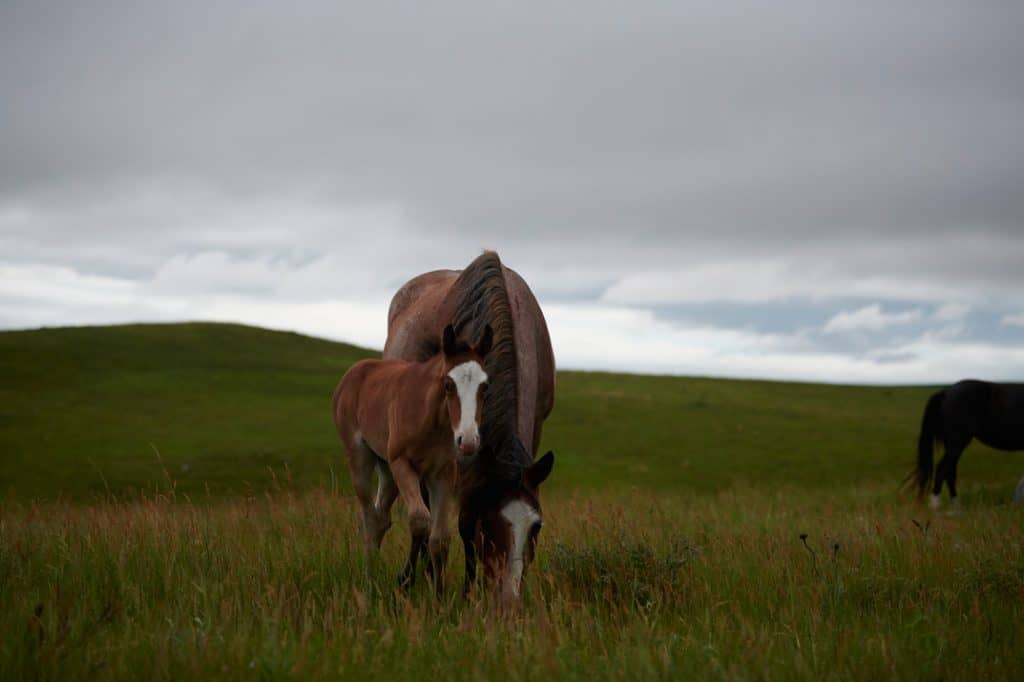Wild Horse Management Plan for the last 40 years, Leo and Frank Kuntz have been involved in helping to preserve a historically genetic and threatened type of horse, the Nokota Horse ®, the horse of the Northern Plains natives. There are less than a thousand of this type of horse alive today. This horse was a gift to the Plains natives from their creator. The horse pulled their travois, the buffalo horse was for hunting, and the most prized was the warhorse, the fastest and strongest.
DIE, PONY, DIE –TRNP (Theodore Roosevelt National Park)
During the mid-1800s, the policy was to destroy everything when the military took a village. Homes, clothing, and food were burned and many of their horses were shot or their throats slit. Even after the natives were put on reservations, the cavalry was sent to round up the native-type horse under the premise they were carrying disease and either shoot them or sent them to auction.
Nakota Horse Conservation
This type of horse was in the TRNP when it was fenced in the early 1950s. Park policy then became total elimination of the Nakota horses in the Park. Box canyon type round-ups were attempted, with little success; hay was poisoned and fed; local ranchers were hired to rope some and others were shot. Fortunately, some local residents and others asked ND congressional delegates in DC to help. The TRNP decided to keep the horses as a historical demonstration herd.
This all changed in the late 1970s and early 1980s. TRNP superintendent Harvey Wickware made the decision to change the geno- and phenotype of the wild horse herd. They introduced domestic studs (quarter horse, shire-cross, and an Arabian) who could not compete with the wild native studs to keep and maintain a mare band. So policy became the removal of the Native wild studs, allowing the introduced domestic studs to make an impact on the herd. They did this by using helicopters and outriders to round up the wild horses. Their first attempt in the early 1980s was a total disaster. They lost a number of nakota horses running long distances in the heat. During subsequent roundups, the TRNP targeted the native type studs and lead mares.
Largest horse ranch in the world
At the 1986 roundup, Leo and Frank Kuntz purchased 52 head at the TRNP wild horse auction. There they also met Castle McLaughlin, who at the time was working as an intern with the TRNP, and who in 1987 was given a grant to research the history of the wild horses in TRNP, which was funded in part by a grant from the Theodore Roosevelt Nature and History Association.
Dr. Castle McLaughlin is currently associate curator of North American ethnography at Harvard’s Peabody Museum of Archaeology and Ethnology. Her chronicled research showed that the wild horses in TRNP were descended from the Northern Plains natives and the turn of the century ranch horses, with strong historical connections to Sitting Bull and his sub-chiefs, the Marquis deMores (founder of the town of Medora, ND), Theodore Roosevelt (rancher in western ND and US President), and AC Huidekoper (who ran the largest horse ranch in the world at one time near Amidon, ND).
In the 1991 TRNP roundup, The Kuntz brothers were successful at getting the national park to start blood testing their horses and to take out the introduced domestic studs, but what the TRNP didn’t tell people was that most of the shire cross’ offspring were left in the Park. It was suggested that inbreeding could become a problem with the response being that they knew what they were doing. Blood work was done only on nakota horses that were being sold. The TRNP sold 62 head of horses and the brothers bought 11 that were the old native type. The blood was sent to Dr. Gus Cothran at the University of Kentucky. There were 10 horses he called TRNP old-line, adding that they were “extremely divergent” from any other domestic breed.
Preserved genetic Diversity of Nakota Horses
In 2009, the TRNP started using an experimental contraceptive drug called GonaCon, requiring a yearly injection to prevent pregnancy. They began to study the herd to see what effects the drug was having regarding social structure. The study’s credibility is questionable.

The TRNPs last 40 years of ‘management’ (or mismanagement as it were) has resulted in a Nakota horse herd with less genetic diversity and the changing of a historically correct geno- and phenotype horse, as well as culling the younger horses which will result in an older herd dying off of old age, especially with the continued use of the experimental drug GonaCon.In a report called Genetic diversity and origin of the feral horses in Theodore Roosevelt National Park, published on Aug 1, 2018, https://doi.org/10.1371/journal.pone.0200795, it states, “It is recommended that new genetic stock be introduced and that adaptive management principles are employed to ensure that unique mitochondrial lineages are preserved and genetic diversity is increased and maintained over time.”
This is a national park. They should NOT be breeding into extinction a genetically, historically correct horse. There is a need for an interpretive center on the horses, and the slow reintroduction of the Nokota® horses back into the TRNP. Now is the time for the TRNP to do their job … and their job is to do what is right! The TRNP should reintroduce the type of horse that was there before and when the park was fenced, which is the Nokota® horse. It is time to acknowledge the Northern Plains people’s history, horses, and horse culture. The Native peoples’ unique history and culture is a very important part of this Nation’s history. The Nokota® horses need your help.
Contact
Please contact Blake McCann, TRNP Wildlife Biologist at [email protected] and Superintendent Wendy Ross at (701) 623-4466 and ask them to do what is right for the Nakota horses.
Frank Kuntz Executive Director & Co-founder, Nokota Horse Conservancy®
If you would like more information about this topic, please call Frank Kuntz at 701-321-2320.
